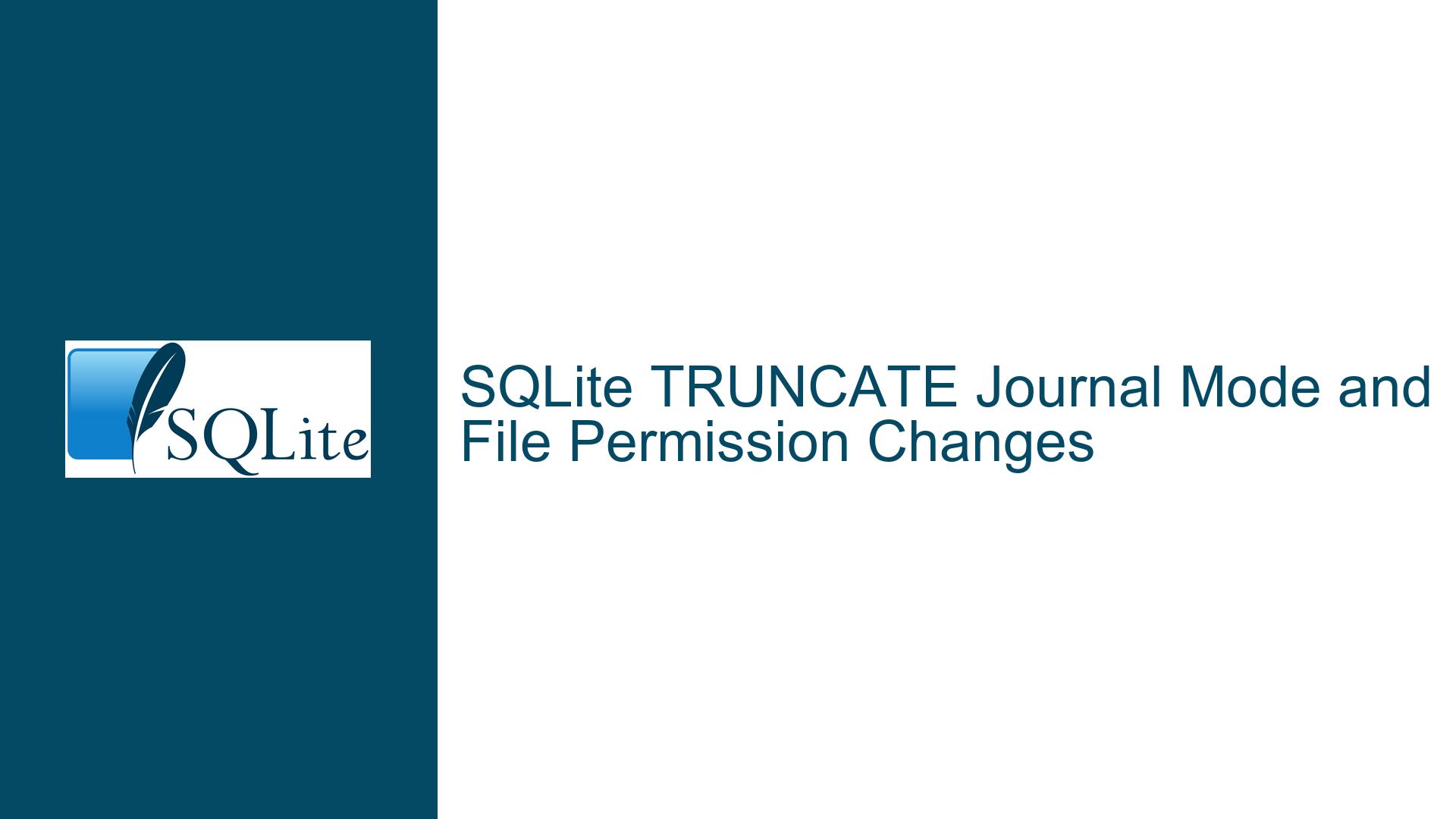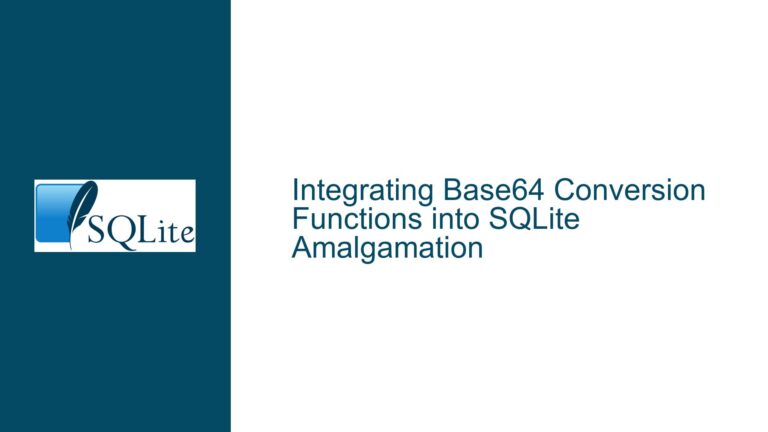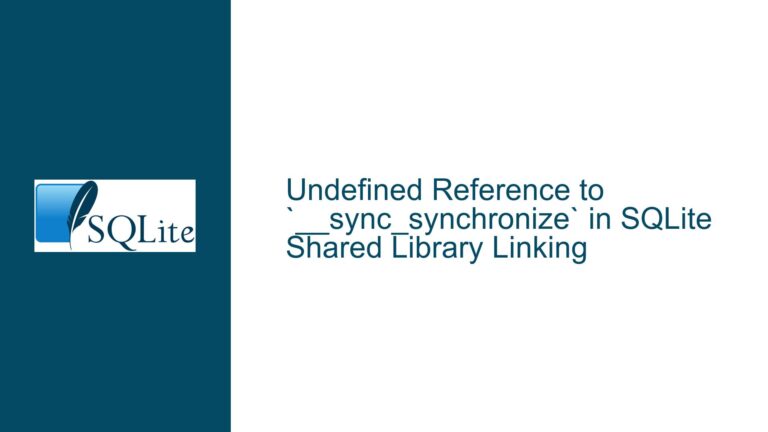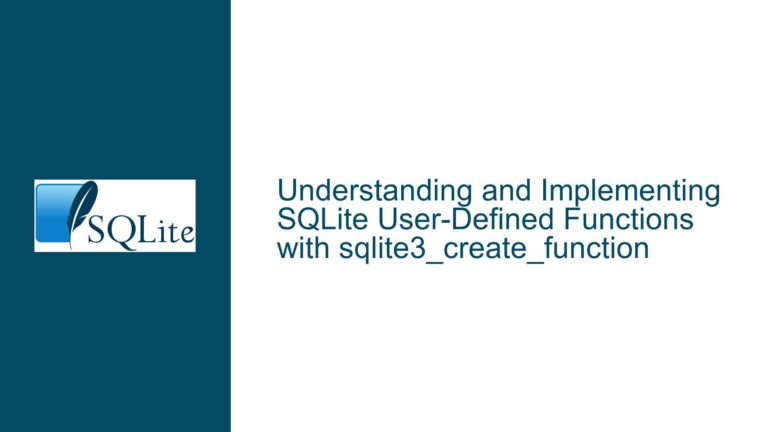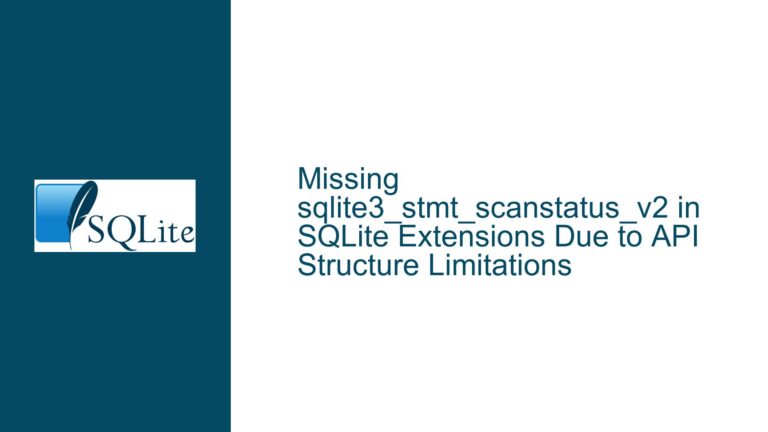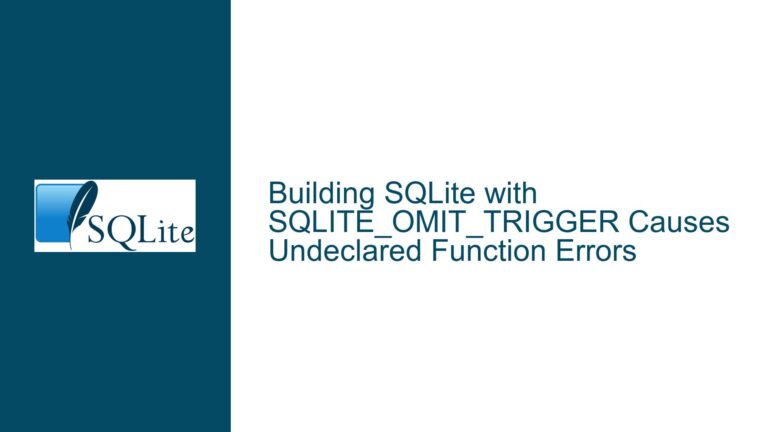SQLite TRUNCATE Journal Mode and File Permission Changes
Understanding TRUNCATE Journal Mode and File Permission Behavior
The TRUNCATE journal mode in SQLite is a method of committing transactions by truncating the rollback journal file to zero length instead of deleting it. This approach is often chosen for its performance benefits, as truncating a file is generally faster than deleting and recreating it. However, this mode has implications for file permissions, particularly when the journal file’s permissions are altered during the transaction process. The core issue arises when the journal file’s permissions are changed to match those of the database file, which can lead to unintended consequences, such as other processes losing access to the database.
When a transaction is committed in TRUNCATE journal mode, SQLite does not delete the journal file but instead truncates it. This operation preserves the file’s inode, meaning the file itself remains in the filesystem, but its content is erased. During this process, SQLite also copies the permissions of the database file to the journal file. This behavior is intentional and designed to maintain consistency between the database and its associated journal files. However, it can cause issues if the journal file’s permissions are explicitly set to allow broader access, as these permissions will be overwritten.
The problem becomes apparent when the journal file’s permissions are changed to rwxrwxrwx (full access for everyone) before the write configuration is executed. After the transaction is committed, the journal file’s permissions are reset to match those of the database file, typically rw-rw-rw-. This change can disrupt other processes that rely on the broader permissions initially set on the journal file. For example, if another process requires execute permissions on the journal file, it will no longer have access after the permissions are reset.
Exploring the Causes of Permission Changes in TRUNCATE Mode
The root cause of the permission changes lies in SQLite’s design to ensure consistency between the database file and its journal files. When a transaction is committed in TRUNCATE journal mode, SQLite performs two key operations: truncating the journal file to zero length and copying the permissions of the database file to the journal file. This behavior is hardcoded into SQLite’s transaction handling logic and is not configurable through standard PRAGMA statements or other settings.
The permission copying mechanism is intended to prevent security issues that could arise if the journal file retained broader permissions than the database file. For example, if the journal file had execute permissions while the database file did not, it could potentially allow unauthorized access or modifications to the database. By ensuring that the journal file’s permissions match those of the database file, SQLite maintains a consistent security posture.
However, this design can lead to problems in specific use cases where the journal file’s permissions need to differ from those of the database file. In the scenario described, the journal file’s permissions are explicitly set to rwxrwxrwx to allow other processes to access the database. When the transaction is committed, these permissions are overwritten, causing the other processes to lose access. This issue is particularly problematic in environments where multiple processes interact with the database and rely on specific permission settings for the journal file.
Another contributing factor is the filesystem’s handling of file permissions during truncation. When a file is truncated, its inode remains the same, but its content is erased. The filesystem typically preserves the file’s metadata, including permissions, unless explicitly instructed to change them. In the case of SQLite’s TRUNCATE journal mode, the permission copying is performed by SQLite itself, not the filesystem. This means that even if the filesystem supports preserving permissions during truncation, SQLite will still overwrite them to match the database file.
Resolving Permission Issues in TRUNCATE Journal Mode
To address the permission issues caused by TRUNCATE journal mode, several approaches can be considered. Each approach has its trade-offs and should be chosen based on the specific requirements of the environment and the use case.
One possible solution is to avoid using TRUNCATE journal mode altogether and instead use a different journal mode that does not involve permission copying. For example, the WAL (Write-Ahead Logging) journal mode does not truncate or delete journal files and does not copy permissions from the database file. Instead, it uses a separate WAL file to record changes, which can be managed independently of the database file’s permissions. However, WAL mode has its own set of considerations, such as increased memory usage and potential compatibility issues with certain filesystems.
Another approach is to modify the permissions of the database file to match the desired permissions of the journal file. Since SQLite copies the permissions of the database file to the journal file, setting the database file’s permissions to rwxrwxrwx would result in the journal file having the same permissions after a transaction is committed. However, this approach may not be feasible in environments where the database file’s permissions need to be more restrictive for security reasons.
A more advanced solution involves using filesystem-level mechanisms to preserve the journal file’s permissions during truncation. For example, on Linux systems, the chattr command can be used to set immutable attributes on the journal file, preventing SQLite from modifying its permissions. However, this approach requires careful management of file attributes and may not be supported on all filesystems or operating systems.
In environments where multiple processes interact with the database, it may be necessary to implement a custom permission management system. This system could monitor changes to the journal file’s permissions and restore them as needed after each transaction. While this approach adds complexity, it provides fine-grained control over file permissions and ensures that other processes maintain access to the database.
Finally, if none of the above solutions are feasible, it may be necessary to modify SQLite’s source code to disable the permission copying behavior in TRUNCATE journal mode. This approach requires a deep understanding of SQLite’s internals and should only be undertaken by experienced developers. Any modifications to the source code must be thoroughly tested to ensure they do not introduce new issues or compromise the database’s integrity.
In conclusion, the permission changes caused by TRUNCATE journal mode in SQLite are a result of the database’s design to maintain consistency between the database file and its journal files. While this behavior is generally beneficial for security and consistency, it can cause issues in specific use cases where the journal file’s permissions need to differ from those of the database file. By understanding the underlying causes and exploring potential solutions, it is possible to mitigate these issues and ensure that all processes maintain access to the database.
